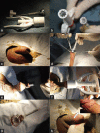Disposable circumcision suture device: clinical effect and patient satisfaction
- PMID: 24759586
- PMCID: PMC4023377
- DOI: 10.4103/1008-682X.127816
Disposable circumcision suture device: clinical effect and patient satisfaction
Abstract
In our experience patients undergoing circumcision are mostly concerned about pain and penile appearances. We conducted a prospective randomized trial to assess the benefits of a new disposable circumcision suture device (DCSD). A total of 942 patients were equally divided into three groups (conventional circumcision, Shang ring and disposable suture device group). Patients in the DCSD group were anesthetized with compound 5% lidocaine cream, the others with a 2% lidocaine penile block. Operation time, intra-operative blood loss, incision healing time, intra-operative and post-operative pain, the penile appearance and overall satisfaction degree were measured. Operation time and intra-operative blood loss were significantly lower in the Shang ring and suture device groups compared to the conventional group (P < 0.001). Intra-operative pain was less in the suture device group compared with the other two groups (P < 0.001); whereas post-operative pain was higher in the conventional group compared to the other two groups (P < 0.001). Patients in the suture device (80.57%) and Shang ring (73.57%) groups were more satisfied with penile appearances compared with the conventional circumcision group (20.06%, P < 0.05). Patients in suture device group also healed markedly faster than the conventional group (P < 0.01). The overall satisfaction rate was better in the suture device group (78.66%) compared with the conventional (47.13%) and Shang ring (50.00%) groups (P < 0.05). The combination of DCSD and lidocaine cream resulted in shorter operation and incision healing times, reduced intra-operative and post-operative pain and improved patient satisfaction with the cosmetic appearances.
Figures

Comment in
-
Circumcision standards: can we improve further?Asian J Androl. 2014 Nov-Dec;16(6):917. doi: 10.4103/1008-682X.133328. Asian J Androl. 2014. PMID: 25130585 Free PMC article. No abstract available.
-
Commentary on "Disposable circumcision suture device: clinical effect and patient satisfaction".Asian J Androl. 2015 May-Jun;17(3):516. doi: 10.4103/1008-682X.143758. Asian J Androl. 2015. PMID: 25532582 Free PMC article. No abstract available.
References
-
- Cortés-González JR, Arratia-Maqueo JA, Martínez-Montelongo R, Gómez-Guerra LS. Does circumcision affect male's perception of sexual satisfaction? Arch Esp Urol. 2009;62:733–6. - PubMed
-
- Rosario IJ, Kasabwala K, Sadeghi-Nejad H. Circumcision as a strategy to minimize HIV transmission. Curr Urol Rep. 2013;14:285–90. - PubMed
-
- Hayashi Y, Kohri K. Circumcision related to urinary tract infections, sexually transmitted infections, human immunodeficiency virus infections, and penile and cervical cancer. Int J Urol. 2013;20:769–75. - PubMed
Publication types
MeSH terms
LinkOut - more resources
Full Text Sources
Other Literature Sources
Medical

